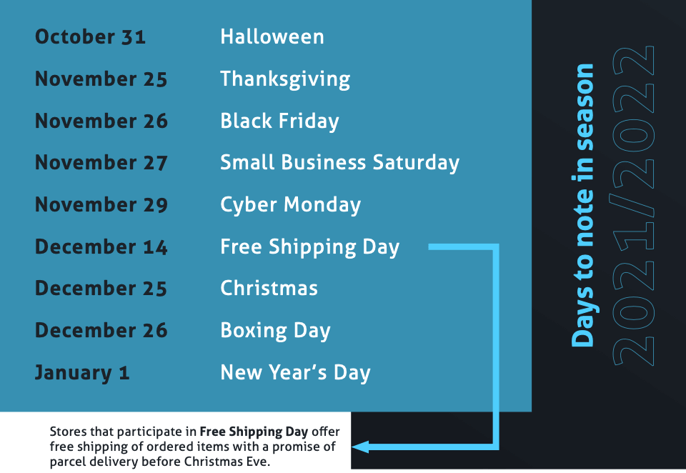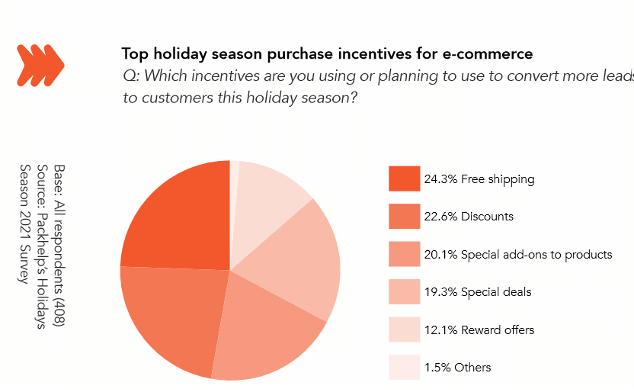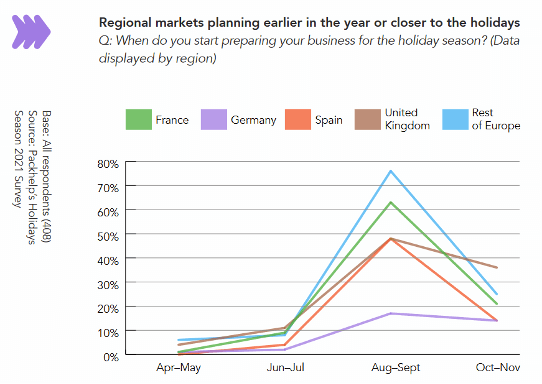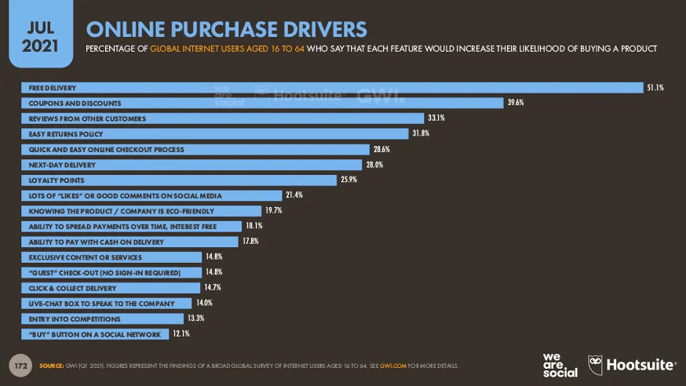In order to answer your request, we are obligated to process the data given above. Sometimes, however, we would like to use them for slightly different purposes, such as statistical data or informing you about our new products and services.We promise that we will use the given information for communication purposes only. We also remind you that you can unsubscribe from our mailing at any time (see Privacy Policy).
Black Friday, Cyber Monday, and, of course, Christmas is a time when salespeople rub their hands together: both to work hard and to see profit calculations. Before however, happily humming the magic truth about the most wonderful time of the year under your breath, you have to almost literally arm yourself to the battle for the consumer and prepare… logistical issues that, let’s agree: can be a challenge. What should be done to turn this time into a busy, fruitful, and (as far as possible) hassle-free time instead of a love-hate relationship?
High Season – basic information, data, and statistics
When you think about the so-called High-Season, the first thing that comes to our mind is probably Christmas/Hannukah time (Q4, or October through December).
And, of course, you are right. We remember, however, that the logistic challenges do not end only in this period. Increased purchases are also the domain of other days: Halloween, Valentine’s Day, Mother’s Day, or back-to-school period. However, this list does not exhaust all the possibilities. Some brands artificially generate additional days that require increased sales and profits and… yes, logistics work. Without looking too far, let’s mention Amazon’s Prime Holiday, which previously lasted only 12 hours and has recently been extended to 48 hours. Is this decision paying off? According to Insider Intelligence forecasts, 48-hour Prime Day was worth $12 billion worldwide, breaking all records of revenue increases to date.

What’s more, when it comes to the logistics industry, the issue of increased work related to the high season is slightly longer than for e-retailers themselves: there is also work connected with the process of returning ordered goods. Peak shipping season means an extraordinarily significant increase in orders and, therefore, the shipments and returns that you have to process. The more packages to handle – the higher the probability that the supply chain may be disrupted.
The extended season in the logistics industry is not all you will have to deal with this year – experts predict that Christmas 2021 will start… earlier. Consumers fear that with the coming waves of the Covid-19 pandemic, purchases and related deliveries may be uncertain and delayed. What’s more, customers also remember the fact, according to which some transport companies charge higher rates for logistics services during the holidays, explaining the multitude of orders and the difficulty of their implementation.
Retailers are doing everything in their power to boost business strategies for the holiday season. They take all tactics allowed and use tactics such as:
- adding new products to offer,
- taking care of social commerce,
- spending more money on advertising,
- improving customer experience,
- expanding to new markets,
- adjusting customer support,
- increasing the number of team members.
An interesting time offers itself, and the associated (lower) prices are one thing – today, customer satisfaction is not so simple. As shown by the data collected by PostNord, one of the factors that influence the decision to buy a product is the choice of supplier and … the speed of delivery; what complicates further the process is the growing popularity of cross-border online shopping.
Many companies also try to get more leads by offering certain discounts or additions in the sales process itself. At the forefront of these practices are typical discounts, which are ahead of nothing else than free shipping. Moreover, such treatment is expected by the consumers themselves. According to the data collected by the Forrester research company, US shoppers have particularly high expectations. 50% of respondents indicated free shipping with no minimum order value, a discount on their total purchase (49%), guaranteed on-time delivery (36%), and free returns shipping (34%). 
In addition, the delivery process itself is influenced by many different factors: some items are much more difficult to transport than others. Some goods are kept in stock, others are not; some of them are subject to regulations that the carrier needs to take care of.
Taking care of supplies has been a challenge throughout the whole year; in high-season, it may seem almost like mission impossible. The demand grows so much it can limit capacity, make freight more expensive, and give logistics a headache. Nonetheless, since this is a phenomenon that happens every year, companies should foresee it before the madness sets in.
However, we have good news – thanks to earlier preparations and focusing on modern technologies, this process can be tamed. Remember: taking care of customer satisfaction is taking care of the brand image – and this, in the end, is the basis for concluding contracts, also in the e-commerce industry.
A short guide on how to prepare for heavy traffic
Last year, due to the outbreak of the Covid-19 pandemic and the ban on stationary trade imposed by some countries, was not only very fruitful for the logistics industry but also a real challenge. Logistics coped with the increased traffic and, at the same time, learned a lot.
Unfortunately, also the buyers themselves have suffered in part from learning the logistics industry. As shown by data collected by Forrester in the 2020 post-holiday survey, as many as 1/5 US online holiday shoppers experienced longer than expected shipping time frames, 20% faced late deliveries, which resulted in fewer than one in 10 having online orders canceled. Consumers and retailers have seen for themselves just how fragile the supply chain can be. This year, only 10% of US online adults declare “guaranteed on-time delivery” as a top reason they will shop online in this holiday season – down from 17% just a year earlier.
So let’s check out how to prepare better this time – the knowledge gained from new challenges and previous years is worth translating into the high season – and be well prepared for the deluge of shipments that awaits us all soon. Let’s check what we can do before the increased parcel traffic starts in earnest.
1. Plan Earlier – Forecasting and Prevention
During the peak season, you can expect to see freight rates rise and freight capacity plummet. That activity can raise significant challenges for retailers and all the more for those managing the supply chain and logistics. That is exactly why as many as 62% of e-commerce brands start prep already in August, according to Packhelp data. Only 27% of the companies questioned in the report wait until November to prepare for the season.
In relation to the above data, more than half of the surveyed companies have already begun to prepare for their busiest season – but they don’t feel ready for the rush of orders they expect this year. As many as 22% admit to being completely unprepared, only 4% declare being fully prepared. Others say they have a lot of work ahead of them. Interestingly, the percentage distribution of these declarations differs depending on the country – almost 40% of respondents indicated the worst level of preparation does business in France.

If you want to optimize your warehouse, you first need to measure the performance of your operations to establish a baseline. How many items are your pickers retrieving per hour? How long does it take to sort and pack orders or replenish totes? How are incoming orders prioritized, and how many orders does the facility ship on a given day? You can’t improve a process until you measure it.
Taking inventory is the only way to know what you have, what you’re about to run out of, and what’s been misplaced or lost. Then, moving forward, perform regular cycle counts that won’t disrupt operations. Maintaining accurate data can help you minimize safety stock and, therefore, money tied up in inventory.
Fewer touches mean fewer errors – and lower costs. Conventional wisdom dictates that the fewer hands touching a product as it makes its way to a customer, the better. More touches mean more costs and more opportunities for mistakes to be made. Evaluate the flow of inventory into and out of the warehouse to see how many steps are involved in fulfilling orders, and look for ways to reduce that number.
High season shipping on time is only half the battle; here comes another problem, the so-called reverse logistics.
The more goods are sold and delivered, the more goods are… returned, according to the laws of statistics. Reverse logistics is exactly this return process to the store or manufacturer. Contrary to expectations, from the point of view of shops, it is not the end of the sales world: thanks to returns, shops learn about customer behavior and expectations. From the point of view of the logistics people, this is undoubtedly another challenge that you need to plan ahead of time.
2. Have a realistic budget
Walking with your head in the clouds on business matters is valuable – as long as you work in the creative industry. Logistics, especially in the high season, however, requires keeping your feet on the ground and … as we have already emphasized, planning, including planning (and sticking to) the budget.
Realistic financial assumptions are the key to industry success. You may need to increase shipping rates and consider other possible scenarios. Review historical data: analyze the shipping costs incurred in previous years, explore the potential benefits of contractual rates in place of the market’s spot rates, and consider taking less popular but possibly cheaper routes.
3. The Importance of Regional Carriers
Competing with sellers offering services such as one-day or even same-day delivery can be really difficult and almost impossible to fulfill. If you do not want to disappoint your customers and not be unfounded – use the help of regional carriers.
Their services may prove crucial for fast, relatively cheap and flexible delivery methods. In most cases, these types of carriers offer next-day ground delivery within 400 miles of a shipment’s origin, at the same time at lower rates and with fewer surcharges in relation to the largest market players, i.e. domestic carriers.
4. Leverage Multiple Carrier Services
For starters, it’s worth mentioning that it all depends on the size of our e-commerce business. If it is a small company or one that only started recently, a single-carrier system to manage deliveries may be more efficient. However, when the sales rates start to grow and the effects of the peak season become more and more visible, it may be a good idea to consider using multiple carriers to enhance the effective distribution process. The crucial reason is that different delivery companies have different strengths (or weak points, for that matter). Analysing them will help to choose the best carrier for each type of shipment.
Even if using multiple carriers may be more time-consuming, it turns out that it may be a smarter strategy from an economic point of view. Using different services basically means more options – as some solutions may turn out to be more cost-effective, depending on size, amount, type or destination of the shipment. Delivery costs impact both parts – customers as well as retailers. Therefore, choosing the best carrier is in our business’ own interest, even if that means choosing several companies. Each of them can provide different services or discounts; the offers may also vary in terms of, well, terms and conditions. That means that using several carriers is more likely to help us save money rather than relying on just one company. It is especially important considering the fact that some retailers decide to either cover or at least reduce the cost of delivery (for example, they offer free delivery if the value of the order exceeds a certain amount or the purchase is completed within a certain time slot).
The world of ecommerce is ever-changing, and together with its development grows the customers’ needs and expectations. And those have to be fulfilled, especially during the holiday season. Consumers expect the goods’ shipment to be handled quickly and effortlessly. The price or speed of delivery may also impact their decision while they shop online – they’re more likely to choose the company that can provide the most suitable delivery option. And so, using the services of several carriers can help to meet different customers’ needs.
Using automated systems can work more efficiently and secure the best carrier options for a business. The software can quickly scan all available shipping alternatives and choose the most adequate delivery partner. To maintain efficiency and provide the best shopping experience possible, some brands also decide to merge their e-commerce platform with their multi-carrier management system. It allows customers to choose the option that suits them most regarding the speed and cost of parcel delivery.
5. Shipping Tips and Tricks
The peak season equals rising demand, and the ability to cope with an increased volume of orders is the key to success for businesses. That is why we can’t overestimate the importance of the right shipping strategy. Customers expect the smoothest shopping experience possible, which means there should be no place for delays, mixed parcels, or any other mishaps. What should also be considered is that many consumers leave buying gifts for the very last moment, which can be quite a challenge in terms of on-time delivery. Also, many people expect a bit more customer care when shopping online. To meet expectations, many companies offer things like free returns or complimentary gift packaging (it’s an online world, after all, so parcels shall not only contain great stuff but also look pretty in front of a camera). In an Internet Retailer survey conducted in 2019, 22% of retailers admitted that timely delivery is an obstacle they face regularly in the peak season.[9] That is why it’s nice having a couple of shipping tricks in the sleeve – they may come extremely handy, especially during this busy period.
Logistically speaking, when delivering online orders, delays should be avoided – at all costs. One way to ease the distribution process is to assign priority to full load shipments. Certain items are always more in-demand than others, and when a crate or container is filled only with those certain goods, it is known as a full load. The containers carrying high-priority products should be clearly marked as such. That information will help freighters and third-party forwarders to protect the important cargo and get it delivered on time.
Splitting shipment is the other strategy that may benefit the business, especially during the extremely hectic season. It will ensure that, no matter what unexpected circumstances we may face, at least some of the high-priority goods will be delivered on time. Then, in case of any difficulties or possible delays, the smooth distribution process will still be (at least partially) secured. Splitting the stock is worth considering, even if it may seem more time-consuming or more expensive than sending all freight in one go. For the same reason, it may be a smart move to divide the shipment between a few shipping carriers. As an additional bonus, doing so may help save money, as many carrier companies offer discounted rates for qualifying customers.
Even if it may appear like saving money for some businesses, it is advised to avoid transfers or indirect shipments. Some freighters rely on them; however (especially during the peak season), there is always a possibility that they will be thrown twice, which may increase the danger of additional costs and potential delays.
6. Forewarned is forewarned (literally): buying freight insurance means being protected from the start
The logistics insurance market is experiencing a real revival – as shown by data collected by ResearchAndMarkets.com, it will reach $ 68.5 billion by 2027; marine transport insurance – $38.5 billion.
The peak season is not a good time to look for savings in the context of taking out insurance. As we all know, increased traffic in logistics means a greater number of loads and freight, and thus – increased risk that something may go wrong. Moreover, the peak season also unfortunately means an increased tendency towards cargo theft.
Orders that are damaged on the way or never reach the customer can potentially represent large financial losses and the risk of losing trust in the company. It is therefore important to have a comprehensive insurance policy that protects cargo as broadly as possible, against virtually every possible risk (if necessary, the policy, in addition to land freight insurance, may of course also cover freight delivered by land or sea).
7. Take Care of On-Time Delivery
The shipping peak season is this time of year when both retailers’ and carriers’ capacity is extended nearly to its limits. At the same time, consumers tend to expect more from their online shopping experience. They simply require their parcels to be dispatched quickly and effortlessly. As the delivery process is often crucial when deciding on purchasing an item online, retailers rely on shipping companies more than ever to ensure all packs will be delivered promptly. Therefore, on-time delivery should be one of the main points of focus for e-commerce businesses.
As shown in the report presented by Datareportal, type and speed of delivery are essential for consumers deciding whether to make a purchase online. As much as 51% of responders claim that they would be more likely to buy a product if they were offered free delivery. Meanwhile, 28% point out that they’d make a decision based on the availability of next-day delivery.
Possible disruptions may come as inevitable, so retailers shall use all their professional knowledge and plan ahead to make sure that the delivery process will be as smooth as possible. Planning may include choosing a reliable third-party logistics provider or creating a contingency plan in case of any unforeseen circumstances. Open communication among all parties (retailers, 3PLs and carriers) is the key to success. In order to get ready for the holiday season, some businesses begin conversations with their partners many weeks before October, some as early as in July. However, most European markets start to prepare for the holiday season between August and September. To guarantee the best shopping experience possible, it is also a good practice to highlight what kind of delivery customers shall expect (i.ex. next day, within 48 hours or in 5-7 working days). Another common practice is to provide customers with an online order tracking system for their parcels.
In the e-commerce world, on-time delivery is a standard that builds successful business relations. Customer satisfaction shall be the heart of any enterprise, but meeting expectations affects all sectors of the business, including its financial stability. It’s also important to remember that an unhappy customer is more likely to take time to give a bad review (online or in real life) than a happy one. Therefore, an unpleasant experience with late, lost or damaged delivery will presumably be shared and may result in loss of confidence towards a brand. However, unexpected occurrences happen to even those most prepared. In this case, it’s essential to keep transparency and inform customers promptly.
We can’t stress it enough: good planning is crucial. E-commerce business is stronger than ever, and the numbers grow continuously every year. Online shopping has permanently changed the buyers’ perspective, and to remain competitive, many companies decided to speed up the shipping process. At the same time, businesses that fail to meet customers’ expectations and provide quick shipment are falling out of favour. The stakes are high, as consumers point out fast and reliable delivery (selected by 41% of respondents), in-stock availability of chosen items (35%) and a good returns policy (31%) as their top three attributes when making online purchases.
8. Increase shipments’ cradle-to-grave transparency and visibility
As a part of a long-term strategy (and to build a trustworthy relationship amongst the brand and its customers), it is worth introducing arrangements that will ensure cradle-to-grave transparency and visibility over all shipping processes. Implementing suitable strategies may seem a little time-consuming, but it may help you swiftly manage the peak season. Luckily, many companies provide management systems tailored especially to e-commerce business needs.
Using management systems will definitely boost the efficiency of the whole process and will help you navigate through the holiday season as smoothly as possible. Technological support may include using a digital supply chain control tower or TMS – a multi-carrier transportation management system. Currently, more and more companies use AI to provide their partners with easy-to-use and secure software that improve stock and freight management.Using automated systems also helps to maintain transparency of all steps of the process, which benefits all parties. It allows customers, carriers and retailers to get real-time updates so any possible errors can be recognised and prevented at the very early stage.
During the peak season, it is a common practice for a brand to partner with 3PLs. Their role in maintaining transparency is also essential for the whole process. Experienced partners shall follow the procedures that will ensure visibility when managing shipments and deliveries. Those may include real-time inventory data or keeping up-to-date log books that will provide complete transparency at all stages of your brand’s supply chain. Proper communication between all parties shall also help to avoid other unwanted surprises – i. ex., possible stockouts.
9. Secure drivers and capacity
Carriers play a crucial part in all steps of the supply chain. From transporting goods to the warehouse to last-mile delivery, drivers make the whole business go round – literally.
Especially during the holiday period, congested routes may happen more often than usual. Recent events, such as the pandemic, also showed us that many logistic challenges are difficult to foresee. That is why securing carriers’ capacity should be one of the main points of focus in preparations for the peak season.
Routes congestion, long transit times or lack of drivers are some of the possibilities that may disrupt the shipping process. To secure efficient transportation, brands usually decide to partner with experienced and trusted 3PLs, especially during the peak season.
In preparation for the busier-than-ever holiday period, some companies may even consider turning toward unprecedented solutions. They may go as far as using private transportation services or engaging customer service teams and retail associates in packing and picking up items. However, upfront and thorough planning, using available management systems and having a contingency plan shall help your business to secure the driver’s capacity and overcome any obstacles that may appear.
10. Use technology: automate documentation capabilities (and all that can be automated)
There is no doubt that managing a successful e-commerce business requires lots of effort and dedication. Luckily (as we pointed out in the previous sub-chapters), there are many tricks and focus points that will help you prepare for the demanding holiday season. What connects them is the smart use of many means – and they often include the implementation of AI solutions and management software
Using technologies speeds up the whole purchasing and shipping process, which benefits both customers and retailers. It helps to reduce costs, save time and provide an excellent shopping experience. Digital control of all processes can help bring better results to your e-commerce business. Basically speaking, it allows you to focus on important tasks while most logistics (such as managing orders, shipments and deliveries) is being taken care of by an automated system.
Implemented technologies may include warehouse management system (WMS), order processing system or returns management. The most efficient tools, however, are designed to help you manage the sales process at all stages. From controlling the stock numbers at the warehouse to delivering parcels to customer’s doors, the most efficient software can integrate with all of your e-commerce business.
The benefits of AI can’t be overestimated. Using software helps reduce errors and delays, and that in turn helps to reduce costs. Digital tools mean that real-time notifications can be shared with other parties, and instant access allows early reaction in order to prevent any mistakes that may happen on the way. An intuitive, easy-to-handle system will also improve consumer satisfaction. From tracking parcels to managing returns, using an automated system helps to provide the best shopping experience possible.
Summing Up
If customers are satisfied with the quality of your services and their price is competitive – they will definitely use your offer again and will not look for other alternatives. What’s more, they will also be happy to mention the services you provide to their friends – long live the magic of word of mouth marketing and customer loyalty.
In the logistics industry, customer satisfaction is extremely valuable – it would seem that the services provided are extremely simple at first glance. After all, we are fighting only for the on-time delivery from point A to point B. There are, however, many challenges; what’s more, nowadays the mere transport of goods is not enough. Provide consumers with tools that will make them feel safe – invest in a well-functioning shipment tracking system, in nice and competent people on the hotline; send push information about an update regarding the route of the shipment. Allow customers to give you feedback – and be grateful for it, whether it is good or whether customers express any concerns. Any problems reported will help you prevent them from arising in the next high season, streamline your supply chain, and improve the entire process.
Seems like small things, but believe us – they will please customers and guarantee their return.
If you have any doubts, remember that at Linker Cloud, we are there for you – and we will be happy to help you with your logistics.
This Guide Book is just the beginning of how we can assist you: we will help you start shipping from warehouses near your customers with international infrastructure on demand, improve your fulfillment process for international and domestic sales; we will also not forget about issues related to technology.






